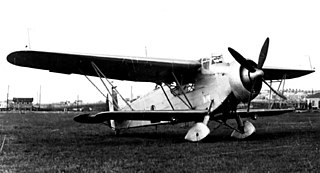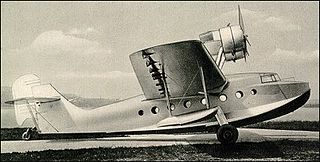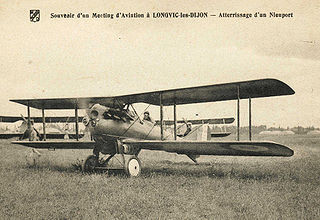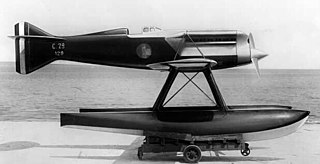| Macchi M.70 | |
|---|---|
 | |
| Role | Light biplane |
| National origin | Italy |
| Manufacturer | Macchi |
| First flight | Late 1920s |
The Macchi M.70, was an Italian light biplane of the late 1920s built by Macchi.
| Macchi M.70 | |
|---|---|
 | |
| Role | Light biplane |
| National origin | Italy |
| Manufacturer | Macchi |
| First flight | Late 1920s |
The Macchi M.70, was an Italian light biplane of the late 1920s built by Macchi.
The M.70 was a two-seat, single-bay biplane with tandem cockpits. The pilot generally sat in the rear cockpit, but both cockpits had flight controls. The fuselage was of wooden construction with plywood skin and was of rectangular section. The wings were of equal span, fairly thick section, and wooden construction; they had fabric covering, and only the lower wing had ailerons. The interplane struts were steel tubes braced with piano wire. The tail surfaces were constructed of steel frames covered by fabric. The rudder was balanced, while the ailerons and elevators were unbalanced. [1]
The aircraft was powered by the Blackburn Cirrus II engine or similar engines in the 56 to 60 kilowatt (75 to 80 horsepower) range, driving a two-bladed tractor propeller. Its wings were hinged and could be folded back along the fuselage, and the aircraft could be converted from landplane to floatplane configuration by removal of its fixed, V-type, straight-axle wheeled landing gear and installation of twin, single-step floats mounted on four struts. [1]
An M.70 flown by an Italian pilot named Agello was among 53 aircraft entered in the 1930 Giro Aereo d'Italia ("Circuit of Italy") race, which more or less circled the Italian "boot" and was held in four stages flown on 25, 27, 29, and 31 August 1930. Rather than be held as a straightforward timed race, the Giro Aereo d'Italia used a handicapping system to determine a staggered start at the beginning of each of the four stages of the race; the system was biased against aircraft with better pure racing capabilities, adjusting start times to favor planes with other characteristics the race organizers deemed useful in general aviation. During preliminary tests held before the race, an aircraft received a higher number of points if it demonstrated a higher rate of climb, shorter takeoff run, and shorter landing distance, and if it had better "touring qualities"—folding wings, comfort, ease of control in flight, and an ability to accommodate safety features such as the wearing of parachutes, among other things; it was penalized for greater weight and higher engine power. The aircraft with the highest point total was allowed to start first in each stage, those with fewer points starting later at a rate of one minute of delay per point behind. [2]
Agello's M.70, powered by a 60 kW (80 hp) Colombo S.53 engine, had among the three shortest takeoff runs and demonstrated the shortest landing distance of any of the 53 entrants, stopping in only 50 meters (164 feet). Overall, the point system placed the M.70 in the ninth starting position, allowing Agello to start with an 11-minute handicap. [2]

Data from [1]
General characteristics
Performance
Related lists

The Fiat CR.1 was an Italian biplane fighter aircraft of the 1920s. Of wood-and-fabric construction, it was designed by Celestino Rosatelli, from whom it gained the 'CR' designation. Its most distinctive feature was that the lower wings were longer than the upper ones.

The PZL-5 was a Polish two-seat touring and sports aircraft of 1930 constructed and produced by the PZL.

The Caproni Ca.100 was the standard trainer aircraft of the Regia Aeronautica in the 1930s. Large numbers of this tandem, two-seat, biplane were built, powered by different engines.

The de Havilland DH.71 Tiger Moth was a British single-seat monoplane, designed to research high-speed flight and to test replacement engines for the Cirrus. Only two were built.

The Reid Rambler, later known under the Curtiss-Reid brand after Reid was purchased by Curtiss, was a biplane trainer/sport aircraft built in Canada in the early 1930s and used in small numbers as a trainer aircraft by the Royal Canadian Air Force.

The IMAM Ro.30 was a 1930s Italian observation biplane designed and built by Industrie Meccaniche e Aeronautiche Meridionali. It was only built in limited numbers before being replaced by the Ro.37.

The Macchi M.C.94 was a 1930s Italian commercial flying boat built by Macchi.

The Fiat AS.1 was a light touring aircraft developed in Italy in the late 1920s.

The Savoia-Marchetti S.59 was a 1920s Italian reconnaissance/bomber flying boat designed and built by Savoia-Marchetti for the Regia Aeronautica.

The Lohner L was a reconnaissance flying boat produced in Austria-Hungary during World War I. It was a two-bay biplane of typical configuration for the flying boats of the day, with its pusher engine mounted on struts in the interplane gap. The pilot and observer sat side by side in an open cockpit, and both the upper and lower sets of wings featured sweepback.

The Nieuport-Delage NiD.29 was a French single-seat biplane fighter designed and built by Nieuport-Delage for the French Air Force.

The Macchi M.24 was a flying boat designed by Alessandro Tonini and produced by Macchi in Italy during the 1920s. Originally intended as a bomber, it was eventually produced for civilian use as well.

The Fiat C.29 was an Italian racing seaplane designed by Celestino Rosatelli and built in the late-1920s by Fiat Aviazione especially for the 1929 Schneider Trophy air race. Unused in the race, of the three aircraft built, two were destroyed in flying accidents while the third is on display in a museum.

The Caproni Ca.70 was a two-seat night fighter and ground attack biplane produced in Italy in 1925. It was the only Italian aircraft designed from the outset as a night fighter.

The Macchi M.53 was an Italian reconnaissance floatplane designed and built in the late 1920s by Macchi for the Regia Marina.

The Short S.36 was a British two-seat tractor biplane, built by Short Brothers for Francis McClean in 1911. It was later developed into the Short S.41 and Short S.45, which were the first of a long series of similar aircraft built for the RNAS and RFC.
The Emsco B-4 Cirrus was a mid-wing, two-seat trainer built in the US in the late 1920s. Six were built and three variants with more powerful engines flown.
The Caproni Ca.66 and Caproni Ca.67 were Italian night bomber aircraft designed to re-equip the post-World War I Regia Aeronautica.

The Macchi M.20 was a single-engine biplane trainer aircraft produced by the Italian aeronautical company Aeronautica Macchi between the end of the 1910s and the beginning of the 1920s.
The IMAM Ro.26, sometimes called the Romeo Ro.26, was a single-engine biplane trainer aircraft produced by the Italian aeronautical company IMAM in the early 1930s. Only one example was built.